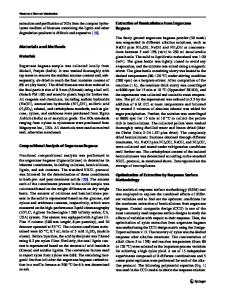Bioethanol Production From Sugarcane Bagasse Hemicellulose Hydrolysate by Immobilized S. shehatae in a Fluidized Bed Fer
- PDF / 801,891 Bytes
- 9 Pages / 595.276 x 790.866 pts Page_size
- 63 Downloads / 318 Views
Bioethanol Production From Sugarcane Bagasse Hemicellulose Hydrolysate by Immobilized S. shehatae in a Fluidized Bed Fermenter Under Magnetic Field Kelly J. Dussán 1,2 & Oselys Rodriguez Justo 3 & Victor Haber Perez 4 Euripedes Garcia Silveira Junior 4 & Silvio S. da Silva 2
&
Geraldo F. David 4 &
# Springer Science+Business Media, LLC, part of Springer Nature 2019
Abstract Bioethanol production from sugarcane bagasse hemicellulosic hydrolysate using immobilized Scheffersomyces shehatae on magnetic biosupports in a fluidized bed bioreactor assisted by magnetic field has been studied. Fermentations were carried out in two experimental setups operating in a magnetically stabilized bed mode with transversal and axial magnetic field lines at 8 and 12 kA/m, respectively. The best results were attained when experiments were carried out using a fermenter assisted by axial field whose ethanol/substrate yield and ethanol productivity were 0.15 ± 0.8E-3 g/g and 0.055 ± 0.3E-3 g/gh. These values were 12 and 34%, respectively, higher than those observed in fermentations with transversal field lines (Tukey’s test, p < 0.05). Thus, these results are attractive and can be considered as a technological advance in the bioethanol production from biomass using this unconventional fermentation technology. Keywords Bioethanol . Scheffersomyces shehatae . Sugarcane bagasse . Hemicelluloses hydrolysate . Unconventional bioreactor . Magnetic field
Introduction The indiscriminate use of fossil fuels is the main cause of increase of the greenhouse gas emissions in the atmosphere, resulting in global warming and problems related to climate changes. Aware of the seriousness of these facts, in the 1970s, Brazil started a program to replace gasoline with ethanol. In this program, sugarcane was chosen as the raw material for the * Victor Haber Perez [email protected] 1
Department of Biochemistry and Chemical Technology, Institute of Chemistry, São Paulo State University-UNESP, Araraquara, São Paulo, Brazil
2
Biotechnology Department, Engineering School of Lorena, University of São Paulo, São Paulo, Brazil
3
Environmental School, Estácio de Sá University, Campos dos Goytacazes, RJ, Brazil
4
Processes Engineering Sector - Food Technology Department, Center of Sciences and Agropecuary Technologies, State University of the Northern of Rio de Janeiro, Av Alberto Lamego 2000, Pq. California, Campos dos Goytacazes, RJ 28013-602, Brazil
production of ethanol and, consequently, studies on technological and agricultural development were intensified [1, 2], resulting in a well-established technology. However, a significant increase in ethanol production can be possible using biomass as feedstock to convert the polysaccharides present in leaves, straw, and sugarcane bagasse into bioethanol, rather than being burned in most factories to produce electricity by cogeneration [3–5]. As a consequence, innumerable researches have been conducted to improve the pentoses fermentation, using strains from several sources such as Scheffersomyces st
Data Loading...











